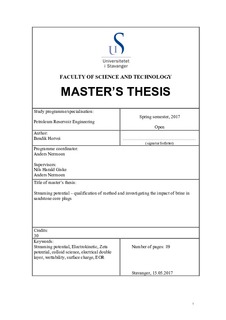| dc.description.abstract | Streaming potential is an electrokinetic phenomenon caused by relative motion of ions
close to a charged surface when a fluid moves past it. By measuring the streaming
potential, information related to the surface properties of the rock, like charge and
wettability can be gained.
To get precise measurements of the streaming potential, a good experimental setup is
required. The main purpose of this thesis was to set up the experiment, get reproducible
results, and investigate if there was a systematic variation in the streaming potential by
varying the brine composition.
It turned out that it was important to reduce the effect of the static noise to get
reproducible results. In that respect we used a method of flowing in both directions, and
varied the flooding rate in a systematic way. The measurement methods implemented
were paired stabilised (applying a constant rate and wait for a stable voltage and
pressure) and pressure ramping with ranges between 240 seconds and 30 seconds
(linearly increase the pressure and measure the streaming potential continuously).
In this work we identified a clear response on the streaming potential and the salinity of
the brine. Higher salinities are trickier to measure as the coupling coefficient is smaller.
The results proved to be successful for salinities of NaCl up to 2 M and CaCl2 up to 0.2
M. At low salinity the measurements were reproducible, and with a variation of 2 % for
the individual measurements. For medium salinities, the coupling coefficient was
around 20 % higher in magnitude for rapid pressure ramping techniques (30 sec) than
for slower ramping techniques (120-240 sec). For the high salinity brines, it was essential
to implement rapid pressure ramping to avoid influence of static voltage. | nb_NO |
